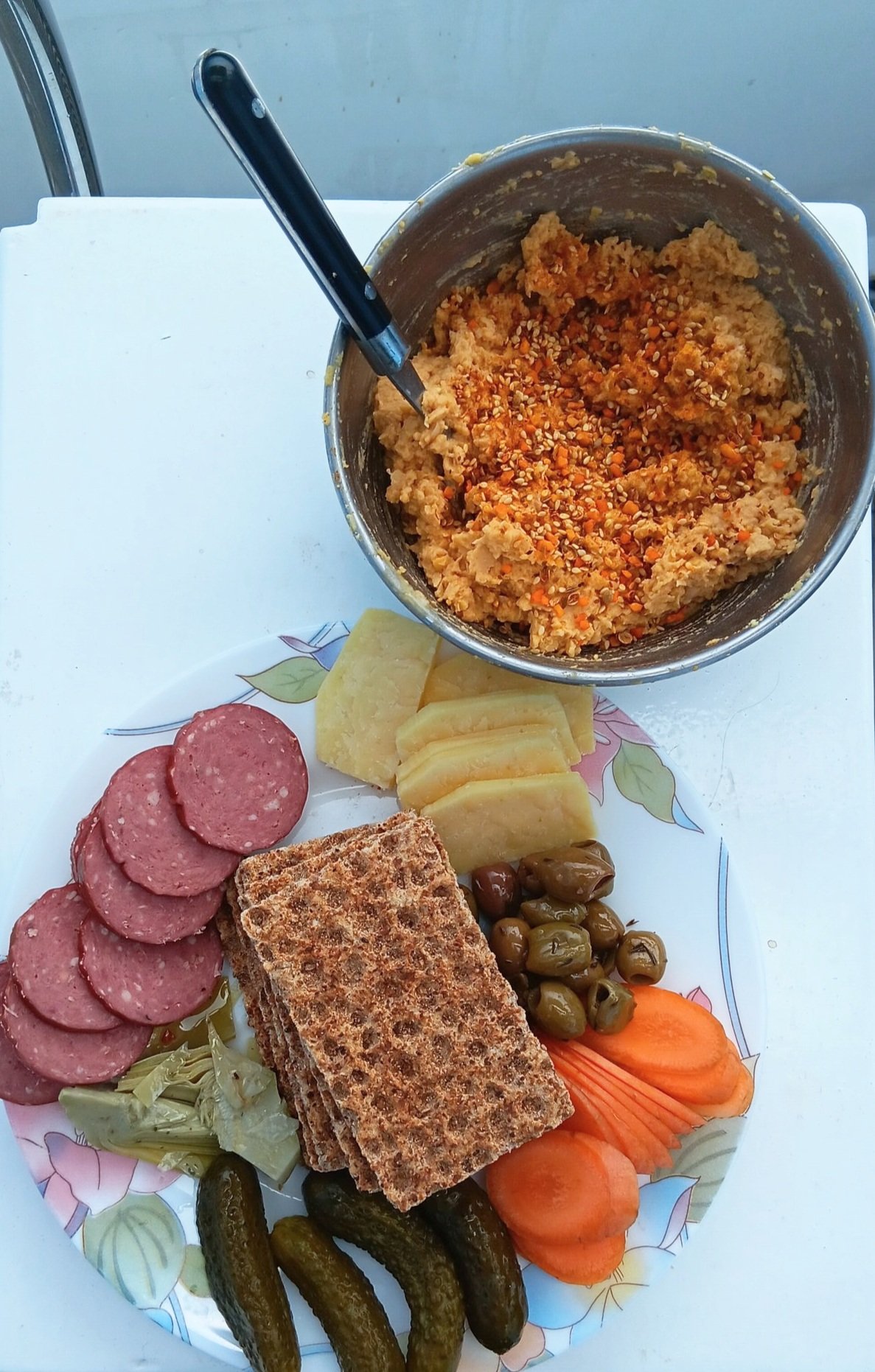Dukkah, the Super-Condiment for Digestive Peace
Dukkah is a BIG DEAL in New Zealand. You can’t go to any self-respecting breakfast joint without finding dukkah on the menu somewhere, usually gracing a plate with halloumi, fried greens and eggs…oooh and home-made sourdough. OK, well that will be one of the better breakfast places, but still. Made from simple ingredients (you probably already have in your kitchen), dukkah adds a beautiful, earthy zing to any plate, but did you know it can also help with digestion? Read on to learn the therapeutic benefits of this quick and easy condiment you won’t be able to get enough of.
Dukkah, also spelled as duqqa or dukka, is a spice blend with a long culinary history in Middle Eastern cuisine. Dukka's culinary history can be traced back to ancient Egypt, where it originated as a staple food in the Egyptian diet. Ancient foods like this are usually eaten not only for the flavor, but also for health benefits, and dukkah has plenty, including reduced bloating, stimulating gastric secretions and improving nutrient absorption - many more healing benefits listed below.
Dukkah is made by combining various dry roasted nuts, seeds, spices, and herbs. The mixture is then coarsely ground to create a flavorful, aromatic blend. It was traditionally used as dip with bread and olive oil (yum), it can also be sprinkled over salads, roasted vegetables, or grilled cheeses, meats, or as a crust for tofu, fish or poultry.
My favorite way to use it, is to top hummus with a layer of olive oil and dukka, then dig in with a variety of veggies and crackers, pita crisps, pickles etc.
The ingredients used in dukka can vary from region to region. It is commonly made with sesame seeds, roasted hazelnuts, almonds, coriander seeds, cumin seeds, and salt. Other variations may include fennel seeds, turmeric, pumpkin seeds, or even dried herbs like thyme or mint. I’ve crafted my blend to be versatile (goes with a variety of other flavors) and contains plenty of the best digestion- supportive ingredients.
HEALING INGREDIENTS:
Cumin: Known for its digestive benefits, this spice aids in the production of digestive juices, thereby enhancing the efficiency of food processing within the body. It has been utilized to alleviate discomforts such as nausea, gas, flatulence, diarrhea, and cramping. Incorporating cumin into lentil dishes can mitigate the gas they may induce. Furthermore, cumin possesses antibacterial properties and has been a staple in Ayurvedic medicine for millennia. It plays the lead role in my Cumin-Scented lentil Stew recipe
Coriander Seed: Another notable spice renowned for its digestive properties, coriander is used in Ayurvedic medicine. It effectively addresses issues like indigestion, gas, nausea, and vomiting. Unlike certain spices, coriander imparts a cooling effect on the body, making it particularly beneficial for individuals prone to feeling overheated. It also boasts anti-inflammatory properties and aids in alleviating discomforts like burning urination. It is a key element in my Morrocan-Spiced Lentils with Grilled Halloumi recipe
Hazelnuts: Rich in beneficial monounsaturated fats such as oleic acids and linoleic acid, hazelnuts are believed to promote heart health and may offer protection against breast cancer. They are abundant in Vitamin E, a potent antioxidant crucial for slowing down aging and maintaining cellular health. azelnuts are a nutrient powerhouse, containing protein, calcium, magnesium, iron, potassium, and zinc, making them beneficial for numerous bodily systems, including cardiovascular and reproductive health.
Black Pepper: Known mainly for its flavor-enhancing properties, black pepper aids in the production of digestive juices, particularly hydrochloric acid, which facilitates the breakdown of fats and proteins. It can also improve digestive discomforts such as gas, burping, heartburn, and constipation. Additionally, black pepper exhibits antibacterial properties and promotes sweating and urination, making it advantageous during infections. Its ability to enhance fat metabolism renders it supportive for weight loss and high cholesterol. The piperine in black pepper, enhances the bioavailability of curcumin, the active ingredient in turmeric, which is why just a pinch is included in my Turmeric Latte recipe.
Fennel Seeds: are used to soothe digestive upsets of all kinds, including abdominal bloating and gas. It works because it relaxes the lining of the intestines, quelling inflammation. They are also rich in antioxidants and nutrients like fiber, potassium, and vitamin C. A little fennel seed goes a long way - fennel plays an integral role in my Lacto-Fermented Lime Pickle, without dominating the flavor.
Sesame Seeds: These tiny seeds are packed with protein, fiber, monounsaturated fats, and essential vitamins like B1 and B2, along with minerals including copper, magnesium, iron, zinc, and calcium. Their rich nutritional profile aids in digestion, promoting gut health and regular bowel movements, thereby alleviating constipation. Moreover, sesame seeds stimulate blood flow and support optimal liver function. Notably, the lignans present in sesame seeds contribute to reducing cholesterol levels by impeding cholesterol absorption from the diet, further enhancing cardiovascular health. Ground sesame seeds are the main ingredient in my Tahini-Hemp Protein Bars which are great substitute for a sweet treat as well.
Pumpkin Seeds are packed with fiber, promoting healthy digestion and regular bowel movements. Plus, they are a great source of essential nutrients such as magnesium, zinc, selenium and iron, which support overall body functions, including immunity, thyroid health and heart function. Moreover, their high content of antioxidants helps combat inflammation and oxidative stress. They add a nutty flavor to my Best-Ever Seed Cracker recipe.
See my other tasty, healing recipes HERE
Dukkah
Makes approximately 2 cups
INGREDIENTS:
1/2 Cup Sesame Seeds (white and/or
black, toasted)3/4 Cup Hazelnuts (roasted, unsalted)
2 Tablespoons Sunflower Seeds
2 Tablespoons Pumpkin Seeds
1/4 Cup Cumin (whole)
1/2 Cup Coriander Seed (whole)
1 teaspoon Black Peppercorns (freshly
ground)2 teaspoons Sea Salt
1 teaspoon Fennel Seed (optional)
DIRECTIONS
Heat a fry pan till medium hot. Toast the hazelnuts for around 3 – 4 mins, stirring constantly until aromatic and just starting to turn golden, then place in a blender.
Next, toast the sesame seeds and add to a blender.
Finally, toast the spices till aromatic (1 -2 mins) and add to the blender. Process briefly until you reach a coarse, grainy texture. Take care not to over blend the mixture as it can become pasty.
Transfer to a bowl or airtight container and enjoy! Serve with olive oil and bread or sprinkle over rice or vegetable dishes. Also great for coating fish, tofu or chicken before grilling.
Keep in a jar in the fridge for up to 3 weeks.
Click here to get this recipe with nutrition information delivered to your inbox
Yours in health,
Camille Hoffman
Naturopath & Nutritionist
Ready to get to the root of your symptoms and heal for real?




